Iron Cross, Tic Tac Toe, Pyramid, etc.
Introduction
This page gives rules for a number of shared card poker games in which the shared (or community) cards are dealt in a particular configuration, and only certain sets of cards are available to be used together as part of the player's final hand. The number of variants of this type that could be invented is almost endless, and several more examples, some quite complex, will be found among the pagat.com collection of invented shared card poker variants.
These variants are normally played in private poker games, in which the players place an ante before the deal and each betting round begins with the first active player to dealer's left.
Iron Cross
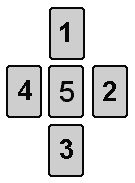 In this game, also known as Church or Criss Cross, five cards are dealt face down to each player, and five cards face down to the table in the shape of a cross - see diagram.
In this game, also known as Church or Criss Cross, five cards are dealt face down to each player, and five cards face down to the table in the shape of a cross - see diagram.
There is a betting round, and then the cards are turned face up in the order indicated, with another betting round after each card is exposed.
In the showdown, each player can use two or more of their five cards together with cards from the cross to form their hand, but the shared cards used must all come either from the horizontal line of three cards (4-5-2) or all from the vertical line (1-5-3).
Variations
The centre card and all cards of the same rank may be wild.
This game can be played high-low, either with declaration or with the highest and lowest hands simply sharing the pot. When it is played with declaration, a player who declares both is only allowed to use one set of three cards from the board, either the horizontal or the vertical line, together with their hand and must make both their high and their low hand from these eight cards.
Iron Cross is sometimes played with only four cards dealt to each player.
The number of betting rounds can be reduced, for example by betting only after the deal, after cards 1 and 2, after cards 3 and 4 and before the showdown.
Tic Tac Toe
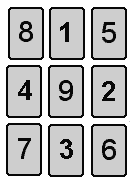 This game is also sometimes known as Criss Cross. Two cards are dealt face down to each player and nine face down cards in a 3x3 grid to the table. In the showdown, players use their two cards together with any row (8-1-5, 4-9-2 or 7-3-6) or any column (8-4-7, 1-9-3 or 5-2-6) or either diagonal (8-9-6 or 5-9-7) to make a poker hand.
This game is also sometimes known as Criss Cross. Two cards are dealt face down to each player and nine face down cards in a 3x3 grid to the table. In the showdown, players use their two cards together with any row (8-1-5, 4-9-2 or 7-3-6) or any column (8-4-7, 1-9-3 or 5-2-6) or either diagonal (8-9-6 or 5-9-7) to make a poker hand.
The cards may be revealed one at a time in the order shown in the diagram with a betting round after each, but that would result in a lot of betting rounds. Therefore some players prefer to reveal the cards in groups, for example 1, 2, 3, 4; betting round; 5, 6, 7, 8; betting round; 9; betting round and showdown. Another possibility is to flip the top row (8-1-5), then the bottom row (7-3-6), then the middle row (4-9-2) with a betting round after each row.
Some deal four cards to each player rather than two, and the player must use exactly two of them witha row column or diagonal of three cards from the table.
Some deal four cards to each player and the player may use 2, 3 or all 4 of these together with 3, 2 or 1 cards from any row, column or diagonal.
Some play that the centre card (9) and all cards of the same rank are wild.
The game can be played high only or high-low with declaration. When played high-low, some allow the high and low hands to be made independently, each using a different row, column or diagonal of the grid.
Tic Tac Toe with Posts
In this version of Tic Tac Toe, as well as placing antes, each player puts up three stakes known as "posts".
Two cards are dealt face down to each player and a 3x3 grid of cards is dealt face up to the table. After a single round of betting, surviving players expose their two cards and declare what is their best hand (the cards do not speak for themselves). The best hand wins the pot and all other players (including those who folded) must place one of their posts into a separate "posts pot".
All players discard their two-card hands but the 3x3 grid remains in place. There is a new deal of two cards face down to each player from the cards that remain in the deck, and there is another round of betting and a new showdown.
This is repeated as many times as necessary. Only those players who still have at least one token are dealt a hand, and if there are insufficient cards remaining to deal them two cards each, all the unused and discarded cards are shuffled to make a new 43-card deck (the 9-card layout remaining in place) and the cards are dealt from that.
When all but one player have losts all their posts, the last surviving player collects the posts pot and the game ends.
The players who still with no actual betting rounds. The result depends only on the deal and on the players correctly identifying what hands they can make.
Tic Tac Toe with choice
Each player is dealt three cards, face down and a grid of nine cards is dealt face down to the table. The player to dealer's left must place a blind, which begins the first betting round.
The last player who bet or raised (if everyone just called or folded this will be the player to dealer's left) chooses two of the down cards to turn face up. Any two cards may be chosen except for the centre card (9), which is the last card revealed. There is another round of betting, which begins with a compulsory bet by the first active player to the left of whoever chose which cards to turn.
This is repeated until the eight outer cards are turned up, after which there is a round of betting with no compulsory bet, begun by the active player to the left of the player who exposed the last two outer cards. Then the centre card is revealed.
In the showdown, each surviving player makes their best 5 card poker hand, using either three cards from their hand and two from the board, or 2 from their hand and three from the board. As usual the board cards must come from a single row, column or diagonal.
The pot, then, is split between the player with the best five card hand made using these rules, and the person who has the highest private card of the same suit as the centre card of the grip. Any odd chip remaining stays in the pot for the next hand. If no surviving player can match the suit of the center card, the whole pot goes to the holder of the high poker hand. If all but one player folded, the last player in takes the whole pot.
Pyramid
There are several shared card games with this name, their only common feature being that the layout is triangular in shape.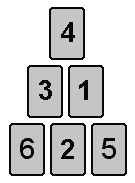
Three intersecting rows
Four cards are dealt face down to each player and six face down to the pyramid as shown in the diagram. The cards are turned face up in the order shown, with a betting round after each.
This is a high-low game with declaration. At the showdown, each surviving player will combine 2, 3 or 4 cards from hand with 3, 2 or 1 cards from the table, but all the table cards used must come from just one of the three sides of the triangle (4-1-5, 4-3-6 or 6-2-5). A player going for both high and low must make both hands from the same seven cards.
Wild cards, shared cards and kill cards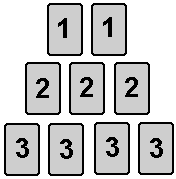
Five cards are dealt face down to each player and nine to a pyramid as shown in the diagram.
After the first betting round the top row of cards is turned face up. All cards of these ranks are wild, but the cards themselves are not available to be used by the players.
After the second round of betting the second row is turned face up. These three cards are shared cards, available to be used by all players along with their hand cards to make a poker hand.
After the third round of betting the last row of four cards is turned up. All cards of the same ranks as these cards, both in the middle row of the pyramid and in the players' hands, must be discarded.
There is a fourth round of betting followed by a showdown.
Other variants
Here is a version of Pyramid contributed Sq2yard.
Yukon Hold'em
According to a (now deleted) Wikipedia article, this game originated in Alaska during the 1970’s and subsequently gained some popularity in the northwestern United States and Canada.
The betting and play proceed exactly as in Texas Hold'em, except the configuration of shared cards is different.
- After the initial betting round, instead of a flop of three cards, the dealer deals two flops of two shared cards face up to the table.
- After the second betting round the dealer deals two "turn" cards, one added to each pair of flop cards.
- After the third betting round the dealer deals a single "river" card.
There is then a final betting round and a showdown. At this point there are seven cards face up on the table: two sets of three each consisting of a two-card flop and the associated turn, and a single river card. Each player can use only one of the sets of three cards (flop + turn) together with the river card and hole cards to make a poker hand.
Z
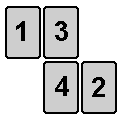 Five cards are dealt face down to each player and four cards to the table in a Z-shape, as shown in the diagram.
Five cards are dealt face down to each player and four cards to the table in a Z-shape, as shown in the diagram.
There is a betting round, and then the cards are flipped face up in the order shown, with a new betting round after each card is exposed.
Hands are formed from exactly three of a player's hole cards together with two adjacent cards from the layout - that is: 1&3, 3&4, or 4&2.
This is a high-low game without declaration. In the showdown, the highest and lowest hands split the pot. A player could win both halves of the pot using different pairs of card for high and low. Low hands use ace-to-five ranking and must be 8-down or lower to qualify. If there is no qualifying low hand, the high hand wins the whole pot.
Variant. Z can be played with declaration, in which case a player declaring both must use the same pair of cards from the board for both their high and their low hand.
Elevator
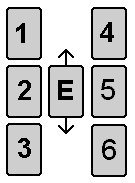 Four cards are dealt to each player and seven face down on the table, as shown in the diagram. In the showdown, each player will choose the position of the elevator "E" (top, middle or bottom) and will then be able to use three cards in a straight line including the elevator along with his or her four hand cards to form the highest and/or lowest five-card hand. The line can be horzontal or diagonal. In other words, the cards available to a player are the four hole cards plus one of the following five sets from the table: 1-E-4, 1-E-6, 2-E-5, 3-E-6, 3-E-4.
Four cards are dealt to each player and seven face down on the table, as shown in the diagram. In the showdown, each player will choose the position of the elevator "E" (top, middle or bottom) and will then be able to use three cards in a straight line including the elevator along with his or her four hand cards to form the highest and/or lowest five-card hand. The line can be horzontal or diagonal. In other words, the cards available to a player are the four hole cards plus one of the following five sets from the table: 1-E-4, 1-E-6, 2-E-5, 3-E-6, 3-E-4.
The seven table cards are turned up one at a time, each followed by a betting round. This should be done in a sequence that delays as long as possible showing two or three cards that can be used together - for example 5, 1, 3, 2, 4, 6, E. Players then declare whether they are going for high, low or both. If both, the high and low hands must both be made from the same seven-card set.
Variations
- The elevator card "E" may be wild.
- Players going both ways may be allowed to use different rows from the table for their high and low hands.